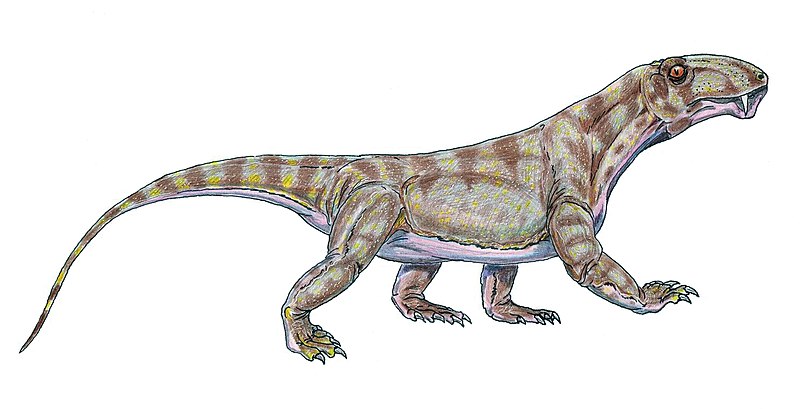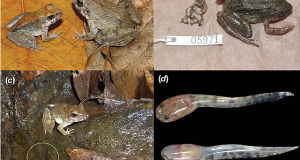 A farm in southern Brazil’s pampas region has yielded the bones of an ancient mammal-like reptile loosely described as a terrifying cross between a Komodo dragon and a tiger. Having worked with both of these modern-day predators, I was immediately intrigued by the newly-described creature (Proceedings of the National Academy of Sciences, Dec., 2011), dubbed the “Pampas Killer”.
A farm in southern Brazil’s pampas region has yielded the bones of an ancient mammal-like reptile loosely described as a terrifying cross between a Komodo dragon and a tiger. Having worked with both of these modern-day predators, I was immediately intrigued by the newly-described creature (Proceedings of the National Academy of Sciences, Dec., 2011), dubbed the “Pampas Killer”.
A Reptile, but…
The Pampas Killer, or Pampaphoneus biccari, haunted Brazil’s grasslands during the Permian Period, some 260 million years ago. It has been classified as a Dinocephalian Theraspid, or “Mammal-like reptile”. Interestingly, today’s monitor lizards are also sometimes described as “mammal-like” by those familiar with them.
The Paleontologists (scientists who research ancient creatures and the history of life on earth) who are studying the Pampas Killer believe it possessed characteristics of both monitors and predatory mammals such as tigers – yikes! It and related dinosaurs may have been an early step in the evolutionary march towards warm-blooded, furred mammals, which appeared 35 million years later. Please see the drawings and articles below for artists’ re-creations of the Pampas Killer and its relatives.
Natural History of a Top Predator
As you can see from the photo of the Pampas Killer’s skull, it was a formidable predator, likely at the very top of the local food chain. Its four enormous canine teeth were hooked, and the body was thick-set and powerful… “like something out of science fiction”, as one paleontologist put it. Up to 10 feet long and weighing approximately 450-600 pounds, it was capable of preying upon Pareiasaurs and other large, heavily-armored creatures.
Scientists are especially excited by the new find because very few carnivorous dinosaurs have been uncovered in South America. Creatures similar to the Pampas Killer are also known from South Africa and Russia, so the new-found fossils may help us to understand an important, world-wide evolutionary trend.
Extinction Crisis, Then and Now
 The Pampas Killer lived during the Permian Period, a time that saw the world’s greatest number of extinctions. Today, amphibians, turtles and many other groups are disappearing at a rate that may, in time, rival even that. I’ve had the chance to work on several related conservation projects and rescue efforts, and was stunned by the scale of the population declines in some regions. You can read more about Asia’s massive turtle declines here.
The Pampas Killer lived during the Permian Period, a time that saw the world’s greatest number of extinctions. Today, amphibians, turtles and many other groups are disappearing at a rate that may, in time, rival even that. I’ve had the chance to work on several related conservation projects and rescue efforts, and was stunned by the scale of the population declines in some regions. You can read more about Asia’s massive turtle declines here.
Further Reading
Artist’s recreation of the Pampas Killer, and more information
Platypus, hagfish, scorpions and many other “living dinosaurs” roam the earth today; their stories and photos are posted here
Abstract of article describing the Pampas Killer’s discovery
Biarmosuchus artist rendering image referenced from wikipedia and originally posted by Juan Carlos Cisneros
Pampaphoneus biccai artist rendering image referenced from wikipedia and originally posted by DiBgd
 That Reptile Blog – Reptile, Amphibian and Exotic Pet Care and Information
That Reptile Blog – Reptile, Amphibian and Exotic Pet Care and Information



That animal wasn’t definately a dinosaur. Dinosaurs is a very specific group of animals. It was a synapsid, directly linked to mammals, not even a reptile. Even the term mammal-like reptiles is a misnomer and fortunately starts falling into disuse. This vertebrate clade diverged a little before the true reptiles and never evolved typically reptilian features. The lizard shape of its early representatives doesn’t tell anything – such shape is ancestral for tetrapods and is maintained by salamanders today. Does it mean that they are reptiles too? Scientific journalism has taken the case of mammalian evolution so wrongly. Everywhere you read you find synapsids described as dinosaurs, or comparisons are made between early mammals, or modern so called primitive mammals, with modern reptiles.
Hello,
Thanks for your interest. The creature is referred to as a “mammal-like reptile” by the paleontologists who discovered and first described it; please see the full text of the National Academy of Sciences article here. Best regards, Frank